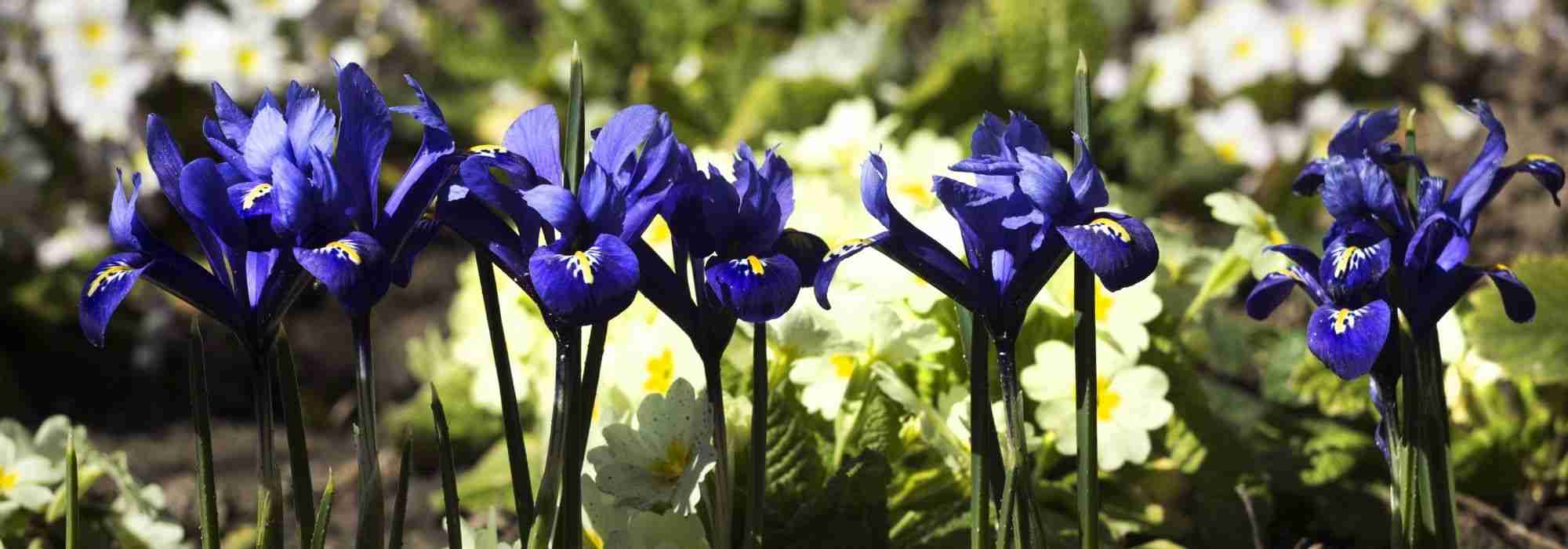
Pairing Iris reticulata
Our inspirations for the garden and home
Contents
The Iris reticulata is one of the first flowers to appear at the beginning of the year. Signalling the return of fine weather, its delicate flowers emerge from February to March. These small bulbs are perfect for rockeries, borders, in a bed, or even in a pot. Planted in groups, the reticulate Iris is often paired with other early-flowering bulbs such as Crocuses, Muscaris, or Hyacinths, creating stunning floral carpets at the end of winter. This dwarf Iris comes in blue, purple, white, or yellow, and sometimes displays distinct details that make each variety unique! These beautiful flowers can also be used for cut flower arrangements. To successfully combine reticulate Irises in your garden or pots, discover our ideas and inspirations!
⇒ Also, check out our guide to learn everything about growing Iris reticulata bulbs.
In rockery
If you want to add colour to a rockery before spring arrives, reticulate Iris are perfect! In sunny exposure, surround them with low plants such as mauve or pink flowering aubrietas that bloom as early as March (Aubrieta ‘Dr Mules Variegated’, Aubrieta ‘Royal Blue’ or Aubrieta ‘Red Carpet’). The Iberis sempervirens, also known as Candytuft, and Arabis caucasica ‘Variegata’ with variegated foliage, bring a touch of brightness with their white flowering. The Meadow Anemone (Pulsatilla patens) remains decorative after flowering due to its feathery seed heads. Finally, choose plants with decorative foliage, such as the Stern Hellebore that shows its flowers from February to April and loves the sun. It dresses the rockery simply with its graphic green foliage veined in white and its very fresh pale green inflorescences. And of course, let’s not forget the grasses (Stipa, Carex, Fescue) and succulents such as Sedums and Houseleeks that are very well suited to sunny rockeries.
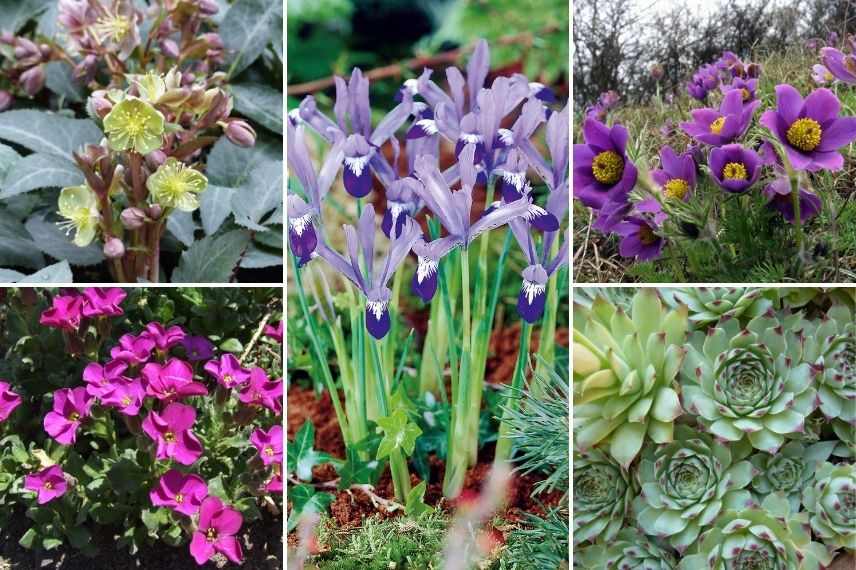
’Stern Hellebore, reticulate Iris ‘Clairette’, Pulsatilla patens (photo Orchi), Aubrieta cultorum ‘Red Carpet’ (photo Wikipedia) and Sempervivum calcareum
Read also
Iris reticulata : planting and growingOn the edge
Iris reticulata create stunning colourful carpets in the heart of winter. If you plant them alone in a border, it will look rather sad after flowering. The foliage can only be cut back when it is completely yellow, allowing the bulbs to store their reserves. Therefore, it is best to combine them with other plants. One can envision a spring marriage of violet-blue, white, and yellow, for example. Consider Iris reticulata ‘Blue Note’ or ‘Scent Sational’. Pair them with white Snowdrops or a Small white Periwinkle (Vinca minor ‘Gertrude Jekyll’, Vinca minor ‘Elisa’, Vinca minor ‘Alba’, and Vinca minor ‘White Power’). For yellow, rely on the classic Daffodils and the False Buttercup Anemone, which reveals a beautiful carpet of flowers from March. The Common Primrose (Primula vulgaris) with its yellow flowers also finds its place in this border. The Scillas, which bloom very early in the year, are also perfect companions, offering star-shaped flowers in white, mauve, blue, or pink (Scilla bifolia, Scilla siberica ‘Spring Beauty’).
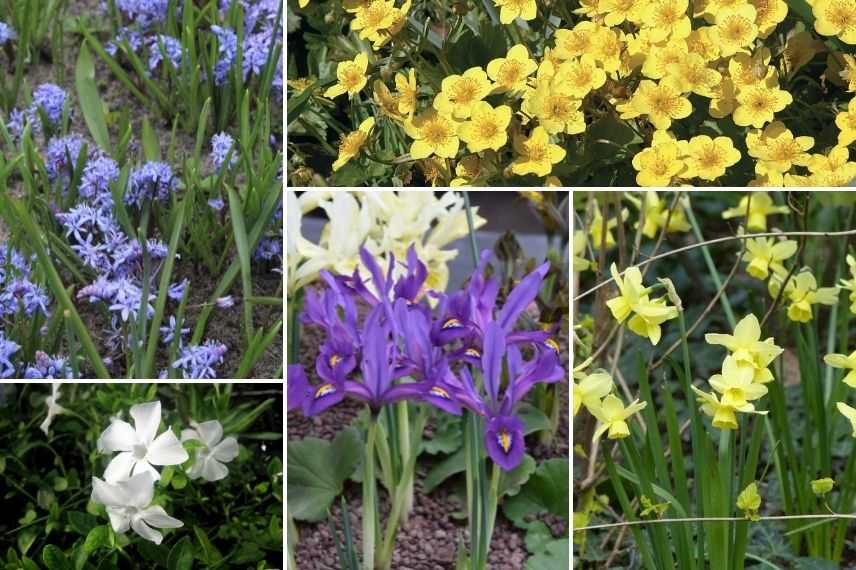
Scilla bifolia, Anemone ranunculoides, Vinca minor ‘Gertrude Jekyll’, Iris reticulata ‘Scent Sational’, and Narcissus triandus ‘Stint’
Discover other Iris Reticulata
View all →Available in 1 sizes
Available in 1 sizes
Available in 1 sizes
Available in 0 sizes
Available in 1 sizes
Available in 1 sizes
Available in 1 sizes
Available in 1 sizes
Available in 1 sizes
Available in 1 sizes
In a flowerbed
Reticulate Irises are perfect for providing a beautiful finish at the front of a border. In the first rank, they are comfortable and enjoy an unobstructed view. Stage them alongside botanical tulips, Ipheion, Anemone blanda (or Greek Anemone), Eranthis, or even avens and Myosotis. Behind them, taller perennial plants easily settle in and take over to bloom from spring to summer: Heucheras, pinks, Astrantia, and Columbines.

Iris reticulata ‘White Caucasus’, Aquilegia ‘Winky Double Red White’, Anemone blanda ‘Blue Splendour’ and Tulip batalinii ‘Yellow Jewel’ (photo Wikipedia)
Read also
Dutch iris: planting and growingIn pot
All Reticulate Irises are suitable for pot cultivation. It is true that a pot solely composed of Iris reticulata looks stunning. However, these bulbous plants can also be grown in pots alongside other early-flowering plants.
- A monochrome display can be created. For example, Iris reticulata ‘Katharina Hodgkin’ with its sky-blue hues pairs easily with the many shades of blue found in Muscari and Hyacinths (such as the varieties ‘Blue Pearl’ and ‘Delft Blue’). Add annual or biennial plants like Pansies (Viola witrockiana ‘Inspire Silver Blue’) or Garden Primroses, which are perennials grown as biennials. The variety ‘Belarina Cobalt Blue’ adds intensity with its dark blue flowering.
- It is also possible to play with contrasts of two opposing colours: blue and yellow. Combine the bright blue Iris reticulata ‘Harmony’ with Spring Crocus ‘Yalta’, blue Horned Violets (for example, Viola cornuta ‘Sorbet Marina’) and yellow ones (Viola cornuta ‘Sorbet Lemon Ice Blotch’), as well as yellow ‘Tête à Tête’ Daffodils.
- The Reticulate Iris can also be planted in pots to create a colour gradient. For a winter flowering pot, Iris reticulata ‘Dijt’ in purple tones is enhanced when paired with a Cyclamen coum in pink, a Viola cornuta ‘Sorbet Pink Wing’, a Wallflower such as Erysimum ‘Poem Lavender’, and an ornamental cabbage.
⇒ Find all our tips for growing Iris reticulata in pots
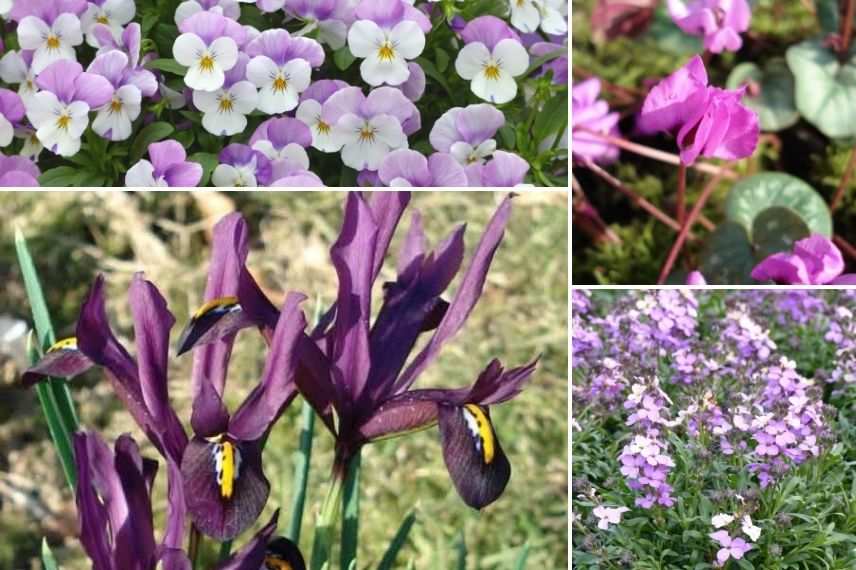 Viola cornuta ‘Sorbet Pink Wing’, Cyclamen coum pink, Iris reticulata ‘Dijt’ and Erysimum ‘Poem Lavender’
Viola cornuta ‘Sorbet Pink Wing’, Cyclamen coum pink, Iris reticulata ‘Dijt’ and Erysimum ‘Poem Lavender’
At the foot of deciduous bushes in a sunny position
With their elegant flowering, Iris reticulata perfectly colour your garden in winter. These small spring bulbs naturalise over the years, forming very floriferous carpets. They are therefore valuable at the front of deciduous bushes that lose their foliage in winter, such as Weigelas, Philadelphus, Physocarpus, Forsythias, and Buddleias. Before planting your bulbs, ensure they will be exposed to full South and will benefit from maximum sunlight. Indeed, these bulbous plants need brightness and an open situation to thrive. Also, be careful not to plant your reticulated Iris too close to the bushes to prevent them from overshadowing the Iris when vegetation resumes. Add other spring-flowering plants to accompany the Iris: Snowflakes, dwarf Corydalis (Corydalis pumila), Garden Auricula, moss Phlox, Caucasian rockcress, or even Montpellier Soapwort.
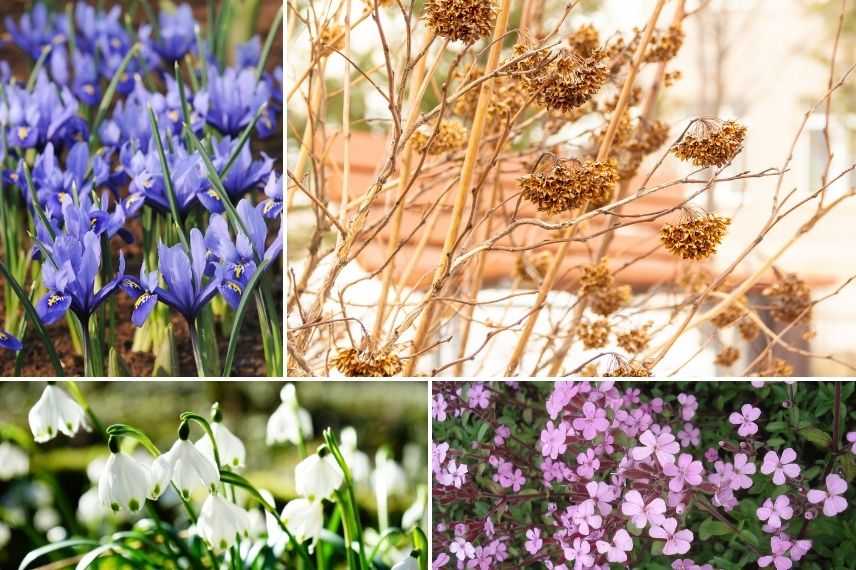
Iris reticulata ‘Harmony’, Leucojum vernum (photo Pixabay) and Saponaria ocymoides at the base of a Physocarpus opulifolius
In association with other Irises
You can simply combine different Iris reticulata together. Plant them in groups to achieve patches of different colours during flowering. For a soft combination, plant the Iris reticulata ‘Natascha’ in white with the Iris reticulata ‘Clairette’ in a soft mauve hue and the Iris reticulata ‘Katharine’s Gold’ with very pale yellow flowers. You can also accompany them with other dwarf Iris such as the Iris unguicularis (or Algerian Iris) and the Iris pumila ‘Blue Denim’, ‘Cherry Garden’ or even ‘Bright White’. These require the same growing conditions as Iris reticulata.
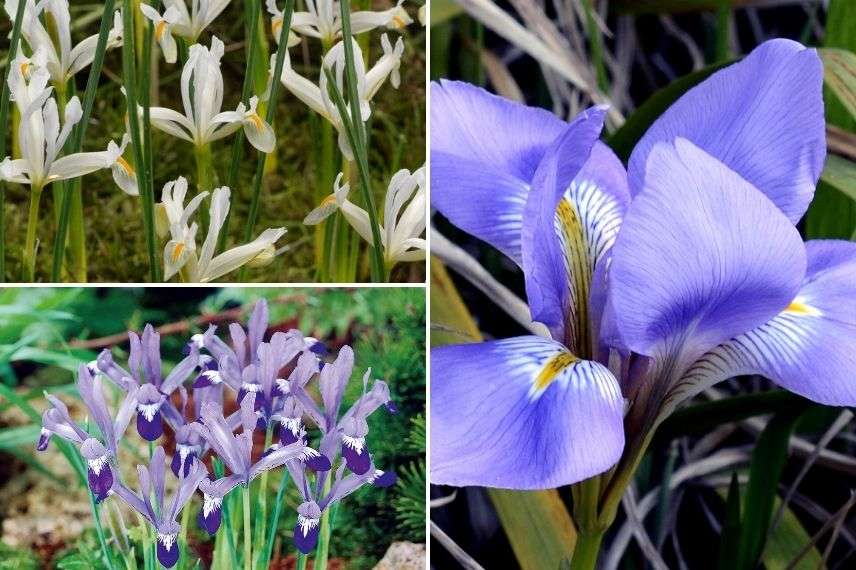
Iris reticulata ‘Natascha’, ‘Clairette’ and Iris unguicularis
In a cut flower arrangement to brighten up the home
While waiting for spring to arrive, create beautiful winter flower bouquets to place in a vase. There are many plants that bloom during the winter period. Imagine a bouquet made of blue and white Muscari, blue Scillas, white Christmas Rose Helleborus niger, branches of Witch Hazel with yellow flowers (Hamamelis intermedia ‘Westerstede’ or ‘Arnold Promise’), Winter Jasmine, and Korean White Forsythia. The multicoloured white, yellow, and blue flowers of Iris reticulata ‘Sea Breeze’ perfectly complement this mix of colours. You can also choose a blue reticulate iris like Iris reticulata ‘Alida’, whose colour will be enhanced by the lighter shades of the other flowers.
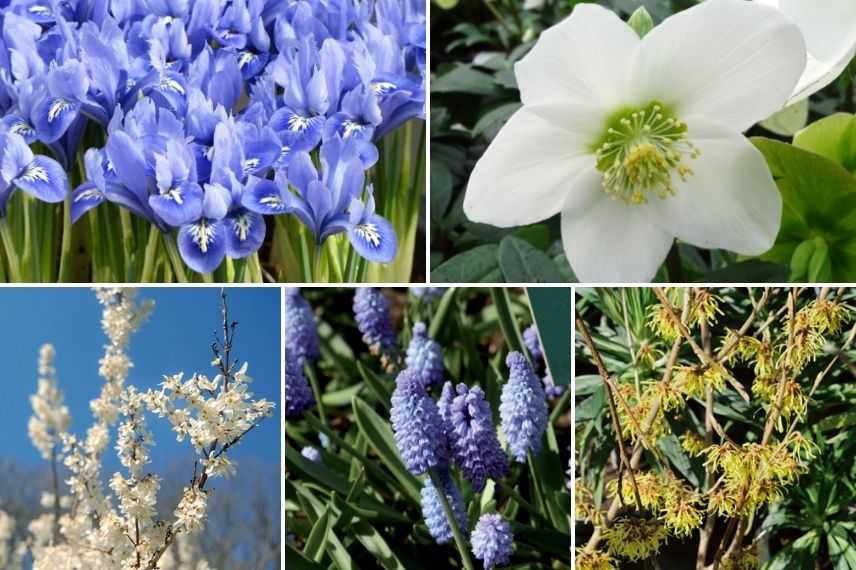
Iris reticulata ‘Alida’, Helleborus niger, Abeliophyllum distichum (photo SharonK), Muscari azureum, and Hamamelis intermedia ‘Arnold Promise’
For further reading
- Discover all our tips for planting Iris reticulata in the ground
- Subscribe!
- Contents
































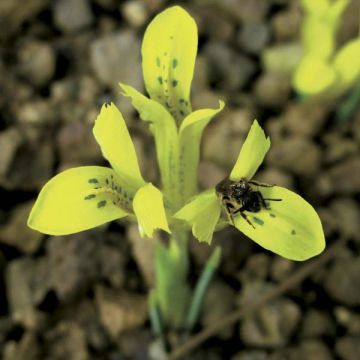

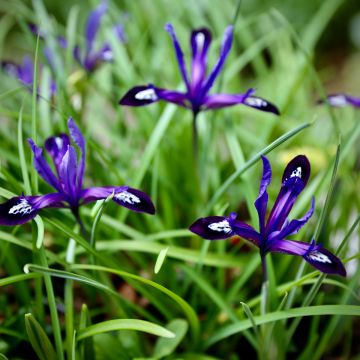

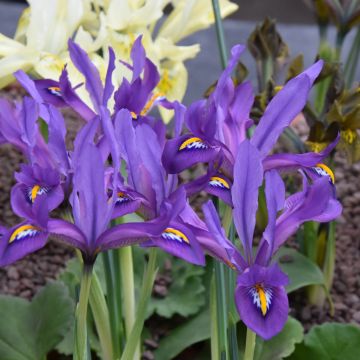


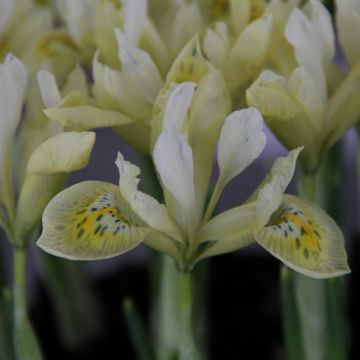

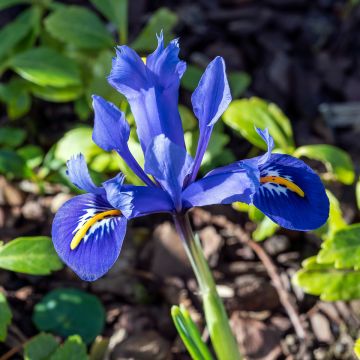
Comments